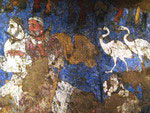 |
| source: 100dorog.ru |
On the eastern side of the fort Afrasiab, between the mosque Hazrat-Hyzr and bridge Siab, stretched Museum of History of Samarkand. The reason for his discoveries was discoveries made in 1965 by the Franco-Soviet archaeological expedition.
Then scientists discovered the remains of the palace of one of the rulers of Samarkand, presumably VII-VIII centuries. Among which underscored the murals depicting the reception the governor, a funeral procession, hunting leopards, and others.
In 1970 the museum was officially opened, when it became possible to deliver the frescoes and other artifacts to the building. Thematically, the museum has been divided into five rooms dedicated to different periods of life in the fort Afrasiab.
The first room is devoted to the history of archaeological excavations in the settlement, which began in the XIX century. It installed a relief map Afrasiab, which marked all the archaeological sites and monuments.
The second hall is connected with early history of Samarkand, which dates back to the VI century BC: pottery VI-IV centuries BC, a model kiln, tools of stone and metal.
The third room is devoted to the period of the conquest of the city by Alexander the Great in 329 BC The established models of walls Afrasiab intended to create a picture of the siege of the city by the great commander. Among the exhibits there are many of the coins, arms, utensils, pieces of flint stones, pieces of wood frame walls.
In the fourth room there are exhibits devoted to the era I-IV centuries, which reflect the spiritual life of citizens, professing at the time of Zoroastrianism (Islam will come only in VII century).
The fifth hall is also dedicated to the spiritual side of life of Samarkand people: among the exhibits are items relating to the cult of fire, fragments of wooden sculptures, home chapel, chapel, murals and much more.
Given the fact that the Arab caliphate came to Central Asia, destroying the culture of Zoroastrians, the museum on the site Afrasiab best illustrates the pre-Islamic culture of Samarkand

